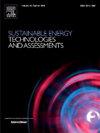Innovating energy governance: The role of nanofluid-enhanced solar vacuum hemispherical cavity receivers
IF 7.1
2区 工程技术
Q1 ENERGY & FUELS
Sustainable Energy Technologies and Assessments
Pub Date : 2025-03-01
DOI:10.1016/j.seta.2025.104255
引用次数: 0
Abstract
This study presents a novel investigation of a solar dish concentrator utilizing a vacuum hemispherical cavity receiver, evaluated through energy, exergy, and environmental analyses. A key focus was placed on using soybean oil-based nanofluids at varying concentrations of 0, 0.025, 0.075, and 0.125 wt% as the working fluid in the solar system. The analyses were conducted against fluctuating solar radiation throughout 2022 in Tehran, Iran. A significant innovation of this research lies in comparing the vacuum hemispherical cavity receiver with a non-vacuum counterpart. The findings indicate that increasing the concentrations of nanofluids can significantly boost energy efficiency, achieving a peak of around 82.55% with a 0.125 wt% concentration in August 2022. Additionally, the overall thermal efficiency trends were closely aligned with solar radiation patterns, reaching a peak of approximately 82.75% during the same month with the same nanofluid concentration. Importantly, higher nanofluid concentrations also play a crucial role in reducing annual CO2 emissions, leading to increased carbon credits. This suggests a strong environmental benefit alongside the performance improvements. The study underscores the promise of vacuum hemispherical cavity receivers in solar dish concentrators as a means to strengthen energy governance by fostering renewable energy investments and innovation through supportive policy frameworks. The insights gained from this research present a novel approach to enhance energy governance while simultaneously minimizing adverse environmental impacts in the future.

创新能源治理:纳米流体增强太阳能真空半球形腔接收器的作用
本研究提出了一种利用真空半球形腔接收器的太阳能盘聚光器的新研究,通过能源、能源和环境分析进行了评估。重点研究了在太阳系中使用不同浓度的豆油基Ti3C2纳米流体作为工作流体,其浓度分别为0、0.025、0.075和0.125 wt%。这些分析是针对整个2022年在伊朗德黑兰波动的太阳辐射进行的。本研究的一个重要创新之处在于将真空半球形腔接收机与非真空接收机进行了比较。研究结果表明,增加纳米流体的浓度可以显著提高能源效率,在2022年8月,当纳米流体浓度为0.125 wt%时,能源效率达到82.55%左右的峰值。此外,整体热效率趋势与太阳辐射模式密切相关,在相同的纳米流体浓度下,同一个月的热效率峰值约为82.75%。重要的是,更高的纳米流体浓度也在减少年度二氧化碳排放方面发挥关键作用,从而导致碳信用额的增加。这表明在性能提高的同时,环境效益也很强。该研究强调,通过支持性政策框架促进可再生能源投资和创新,在太阳能碟式聚光器中使用真空半球形腔接收器是加强能源治理的一种手段。从这项研究中获得的见解提出了一种新的方法来加强能源治理,同时最大限度地减少未来对环境的不利影响。
本文章由计算机程序翻译,如有差异,请以英文原文为准。
求助全文
约1分钟内获得全文
求助全文
来源期刊

Sustainable Energy Technologies and Assessments
Energy-Renewable Energy, Sustainability and the Environment
CiteScore
12.70
自引率
12.50%
发文量
1091
期刊介绍:
Encouraging a transition to a sustainable energy future is imperative for our world. Technologies that enable this shift in various sectors like transportation, heating, and power systems are of utmost importance. Sustainable Energy Technologies and Assessments welcomes papers focusing on a range of aspects and levels of technological advancements in energy generation and utilization. The aim is to reduce the negative environmental impact associated with energy production and consumption, spanning from laboratory experiments to real-world applications in the commercial sector.
 求助内容:
求助内容: 应助结果提醒方式:
应助结果提醒方式:


